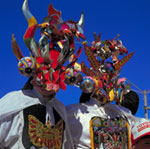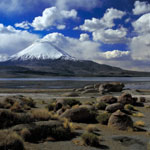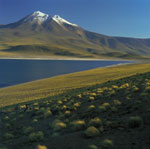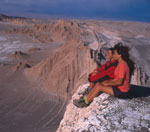 |
The
north of Chile is a land of contrasts,
where the altiplano and the Atacama
Desert come together to offer strikingly
beautiful sights.
The Atacama Desert is said to be
"the driest in the world."
In fact, rainfall has never been
recorded in some areas. What causes
such extreme dryness?
The altiplano, or high plateau region,
receives occasional tropical rain
in January and February. Here, it
is the altitude rather than the
lack of water that challenges life
in this area: only the hardiest,
most specialized flora and fauna
can survive the hardships of life
at over 3500 meters (11,483 ft).
|
Vast and colorful, dotted
with lakes, swamps, salt flats, and geysers,
crowned with volcanoes 6000 meters (nearly
20,000 ft) high, the altiplano links Chile
with the great cultures of the central Andes.
Today, the Chilean high plateau is home
to the traditional Aymara Indians, who wander
among volcanoes and swampy meadows with
their tame llamas and alpacas. They gather
periodically to honor their saints in fantastical
lime-bleached ceremonial villages. Large
areas of this remarkable region are protected
by a system of spectacular national parks,
including Lauca National Park, declared
a World Biosphere Reserve by UNESCO.
Some
of the rainfall is filtered through
the mountains, emerging in springs
and streams to transform the landscape,
creating swaths of wild vegetation
and crops, wildlife habitats and human
settlements, salt flats and salt mountains.
These strips of water and life
have been discovered and used by
humans for generations. San Pedro
de Atacama and other oases on the
Loa and Salado rivers served as
stops on the pre-Incan trade routes
that connected the altiplano with
the Amazon and the coast. The caravans
crisscrossed the desert on pathways
that are now marked only by geoglyphs,
the most impressive archaeological
remains in northern Chile.
|
 |
 |
From north
to south, the main tourist centers
in northern Chile are Arica, Iquique,
Calama, San Pedro de Atacama, and
Antofagasta. Except for Calama and
San Pedro de Atacama, they are all
coastal cities with excellent beaches
unthreatened by clouds, much less
by rain.
Lodging, transportation, and other
services are on a par with those of
the capital. Each city provides access
to a part of the desert, the mountains,
or the altiplano. Walks, ethno-tours,
excursions in all-terrain vehicles,
mountain climbing, and archaeology
are some of the more common activities
in this region.
|
Near
the southern part of this region,
the cities of Copiapó and La
Serena are the doorway to the slender
valleys that cut across the Andes
from east to west. They are known
for their production of the country's
beloved pisco, or grape brandy, and
for having the clearest skies in the
southern hemisphere, which attract
professional and amateur astronomers
from all over the world. |
 |
|